Wine Fermentations
1/23
There's no tags or description
Looks like no tags are added yet.
Name | Mastery | Learn | Test | Matching | Spaced |
|---|
No study sessions yet.
24 Terms
White Wine
Uses clarified juice (solids and liquids)
Drained, pressed, settle/rack, then yeasts are added
Barrel ferment (LAB is added) to barrel age
OR tank ferment
Red Wine
Use the whole unwashed fruit (stems, skin, seeds, bugs) - flavor and color
Must (liquid) ferment (no draining/separation) with added yeasts
Settle/rack (lees is what comes out)
Barrel age
Then regular rack, blend, fine, tartrate stabilization, filter, sterile filter, bottle
SO2 is added
Kills or suppresses other unwanted microbes
This helps control microbial populations so that the desired yeast strain (e.g., Saccharomyces cerevisiae) dominates the fermentation
To prevent oxidation (antioxidant)
Slow down fermentation
Aroma protection
Wine fermentations
From Juice to wine…
Carbs decrease
Nitrogenous compounds decrease (from a.a. and ammonia, fermentations will stop from running out of oxygen)
Ethanol increases

Microbial Ecology of Wine Fermentations
Yeast biomass is grown first
Ethanol increases
Sugar decreases
Ecology of Wine Fermentations
AAB and molds are aerobic but persist in anaerobic conditions
Yeasts
LAB are considered spoilage microbes
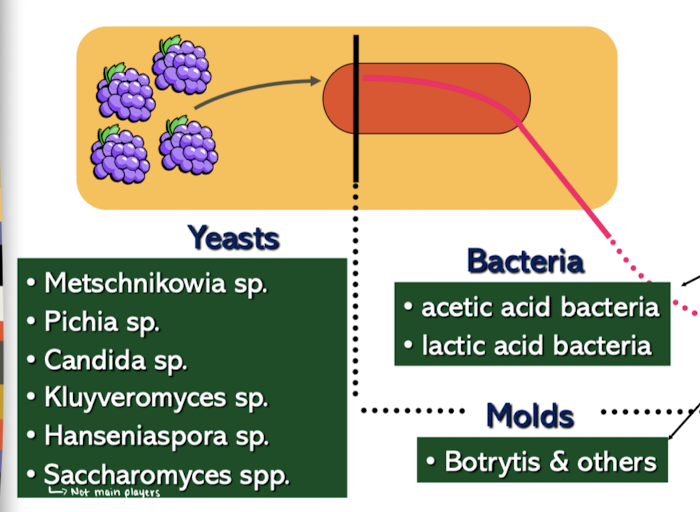
In lower pHs…
Lactobacillus, Lactococcus, Pedicoccus, Leuconostoc, Oenococcus increased at the beginning and decrease as sugar is eaten
Oenococcus seen as sugar decrease, ethanol INCREASES
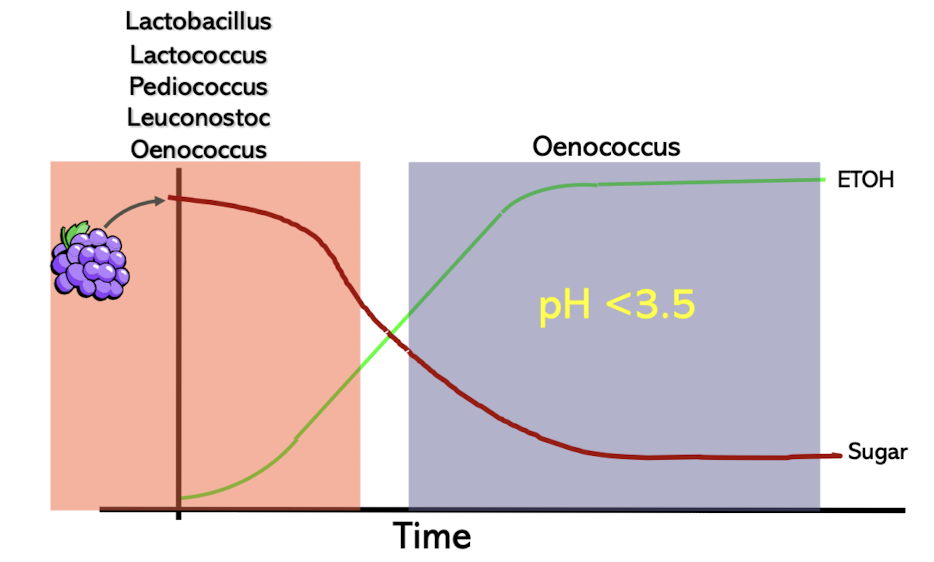
In higher pHs…
Lactobacillus, Lactococcus, Pedicoccus, Leuconostoc, and Oenococcus decrease as sugar is consumed
Lactobacillus, Pedicoccus, Oenococcus are seen as ethanol increased
Microbial Terroir
Microbe makeup will be different based on the region its made in
Saccharomyces cerevisiae
Glucophilic - prefers glucose over fructose (or other)
Yeast Fermentative Metabolism
Uses facilitated diffusion: doesn’t use ATP, works as a “revolving door”
Hexose Transporters - Wine Ferm.
7 main players
Hexose transporter 1 induced in high [glucose] at start of ferm (low glucose affinity) - worse vacuum cleaner
Other 11, main purpose for signaling but also transports
Uses facilitated diffusion
Wine Fermentations - Yeast Nitrogen
A.A., ammonia, nucleotides (DNA), peptides (larger a.a.) are sources of nitrogen in grape juice/wine
Depending on the N-compound - it can be utilized via:
Incorporated into cell metabolism w/o modification (i.e. a.a. taken up and used in protein synthesis)
As a source of nitrogen - cell takes up N-compound and degrades it to get at N, may use or excrete C remaining
As a source of C - cell takes up N-compound and degrades it to get at C, may use or excrete N remaining
Majority of N-compounds used as sole source of N
EXCEPT (because it already has these):
Lysine (K), cysteine (C), proline (P), and to a lesser extent histidine (H), and glycine (G)
Large peptides and proteins
Saccharomyces cerevisiae can’t degrade (no extracellular proteases) but other yeast might

Malolactic Fermentation
Effects on wine (not microbe)
Deacidification (convet to survive in acid longer)
Microbial stabilization
Flavor effects (lactic acid is softer on the palate, diacetyl can be made)
Other endproducts

Oenococcus oeni - “Malolactic” (ML) Starter Cultures
Used as starter culture to induce the malolactic fermentation in wine
Kunkee
Can survive low pH (high alcohol)
Why malate is converted to lactate
No middle steps where carbon is used
CO2 produce, lactate endproduct
Reduces acidity
Prevents spoilage
No significant benefit from pH
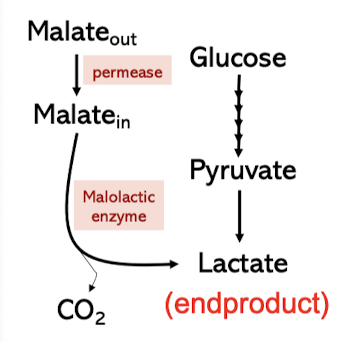
Malate conversion generates proton motif force (PMF)
Conversion to malate to lactate consumes a proton so you don’t have to use ATP to push that proton out of the cell (saves energy) - lowers pH
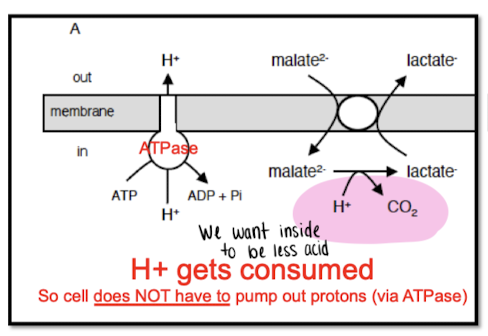
Diacetyl influences in wine
Strain
Oxygen concentration (aeration)
Redox potential of the wine
Citrate concentration
SO2
Impact on LAB growth/metabolism
Direct rxn w diacetyl (and is reversible over time)

Not all ML conversions are friendly…
Can make taints…
Volatile acidity (acetate production)
Mousiness (mouse urine smell)
Acrolein taint (bitter taste)
Mannitol taint (coincides w acetate)
Ropiness (exopolysaccharide)
Biogenic amines (amino acid decarboxylation)
Mannitol taint in hetero. LAB
Fructose —> Mannitol, generation of NAD+
Mannitol crystal test for hetero. pathway ID
Wine Fermentation Spoilage
Vinyl Phenols
Source: decarboxylation & reduction of phenols - off-character, phenolic, animal
Organisms involved
Brettanomyces/Dekkera (major prducers)
LABs (first step)
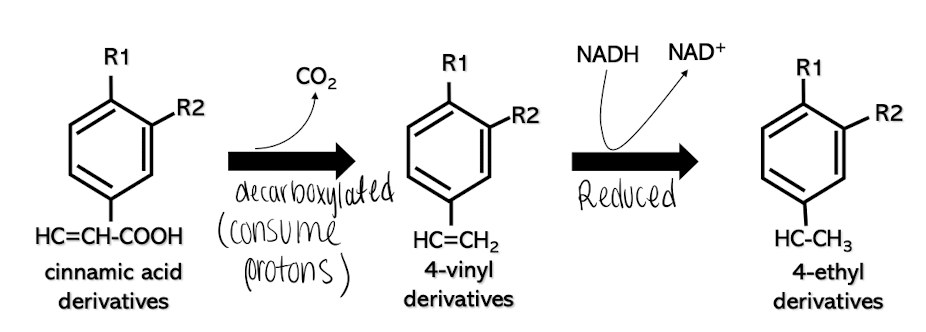
Volatile Phenols
Brettanomyces is main culprit responsible for volatile phenols
Some LAB
4-ethyl phenol results in the descriptors
“poorly cured leather”
“horse sweat”
“used socks”
“horse stable”
Cork taint - Tricloroanisole (TCA)
Musty taint
Organisms responsible: molds, bacteria
Where are they: corks, cardboard, wood in winery (pallets etc.), drains,
Why do they make it?
Detoxification (methylation seems a response to detoxify it)
Cork taint rate 1-8%
Est. cost $100-800 M/yr